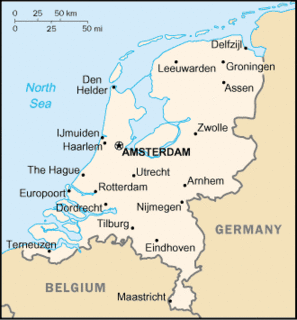
Marieke's talk made me look into the crime statistics in Holland. Here are some of the findings from my previous notes.
In 2004, the Dutch government implemented heightened security measures in response to concerns of international Islamic extremist terrorist activity on Dutch soil. The November 2004 murder of Dutch filmmaker Theo van Gogh by an Islamic extremist in Amsterdam has further increased concerns over Islamic extremist activity in The Netherlands. A number of people have been arrested in connection with van Gogh’s murder and related Islamic extremist activities, and the Dutch government remains on heightened alert.
According to the CIA, while the rate of violent crime in the Netherlands is low, tourists are often targeted for robbery. Visitors frequently fall prey to pickpockets, bag snatchers and other petty thieves. Never leave baggage or other valuables unattended.
There are frequent reports of thefts from specific areas. Within Amsterdam, thieves are very active in and around train and tram stations, the city center and public transport. More specifically, trains to and from Schiphol Airport are considered to be high risk. Thieves often work in pairs; one distracts the victim, often by asking for directions, while the accomplice moves in on the victim's momentarily unguarded handbag, backpack, laptop or briefcase. The timing of these thefts usually coincides with train stops, enabling the thieves to escape.
Confidence artists have victimized a number of tourists. Typically, the person is notified via email of a winning lottery ticket, an inheritance, or other offer, often originating in Africa, which requires his/her assistance and cooperation to conclude. He is asked to forward advance payments for alleged ``official expenses’’ and, often, to come to Amsterdam to conclude the operation. Several people have lost tens of thousands of dollars in such scams. Funds transferred in response to such offers cannot be recovered. Travelers may also contact the Fraud Unit, Amsterdam Police, Police Headquarters, PB 2287, 1000 CG Amsterdam, Netherlands, tel. (31) (20) 559-2380, fax (31) (20) 559-5755.
| Suicide rates in ages15-24 | (6.8 per 100000 people) |
| Suicide rates in ages25-34 | (10.6) |
| Suicide rates in ages 35-44 | (14.2) |
| Suicide rates in ages 45-54 | (12.7) |
| Suicide rates in ages 55-64 | (12.9) |
| Suicide rates in ages 65-74 | (14.0) |
| Suicide rates in ages above 75 | (15.1) |
| Total crime victims: | 25.2% (1999) |
| Total crimes: | 1,305,635 (2000) |
Crime statistics are often better indicators of prevalence of law enforcement and willingness to report crime, than actual prevalence. Per capita figures expressed per 1000 population. In Holland per capita is 79.57 (per 1000 people) that means Holland is 9th on the list while India is 59th .
Country Description Amount
1. Dominica 113.82 per 1000 people
2. New Zealand 105.88 per 1000 people
3. Finland 101.52 per 1000 people
4. Denmark 92.82 per 1000 people
5. Chile 88.22 per 1000 people
6. United Kingdom 85.55 per 1000 people
7. Montserrat 80.39 per 1000 people
8. United States 80.06 per 1000 people
9. Netherlands 79.57 per 1000 people
10. South Africa 77.18 per 1000 people
11. Germany 75.99 per 1000 people
12. Canada 75.49 per 1000 people
13. Norway 71.86 per 1000 people
14. France 62.18 per 1000 people
15. Seychelles 52.92 per 1000 people
16. Hungary 44.97 per 1000 people
17. Estonia 43.36 per 1000 people
18. Czech Republic 38.22 per 1000 people
19. Italy 37.96 per 1000 people
20. Switzerland 36.18 per 1000 people
21. Portugal 34.38 per 1000 people
22. Slovenia 33.62 per 1000 people
23. Poland 32.85 per 1000 people
24. Korea, South 31.72 per 1000 people
25. Mauritius 29.19 per 1000 people
26. Zimbabwe 28.87 per 1000 people
27. Lithuania 22.89 per 1000 people
28. Spain 22.88 per 1000 people
29. Latvia 21.92 per 1000 people
30. Uruguay 21.70 per 1000 people
31. Russia 20.58 per 1000 people
32. Ireland 20.23 per 1000 people
33. Bulgaria 19.98 per 1000 people
34. Japan 19.17 per 1000 people
35. Romania 16.48 per 1000 people
36. Slovakia 16.35 per 1000 people
37. Jamaica 14.32 per 1000 people
38. Belarus 13.15 per 1000 people
39. Mexico 12.84 per 1000 people
40. Tunisia 12.56 per 1000 people
41. Costa Rica 11.97 per 1000 people
42. Ukraine 11.77 per 1000 people
43. Hong Kong 11.68 per 1000 people
44. Macedonia 9.68 per 1000 people
45. Greece 9.63 per 1000 people
46. Venezuela 9.30 per 1000 people
47. Thailand 8.80 per 1000 people
48. Moldova 8.58 per 1000 people
49. Kyrgyzstan 7.50 per 1000 people
50. Malaysia 6.97 per 1000 people
51. Qatar 6.76 per 1000 people
52. Zambia 5.27 per 1000 people
53. Colombia 4.98 per 1000 people
54. Turkey 4.11 per 1000 people
55. Armenia 4.03 per 1000 people
56. Georgia 3.21 per 1000 people
57. Papua New Guinea 2.39 per 1000 people
58. Azerbaijan 1.76 per 1000 people
59. India 1.63 per 1000 people
60. Yemen 1.16 per 1000 people
